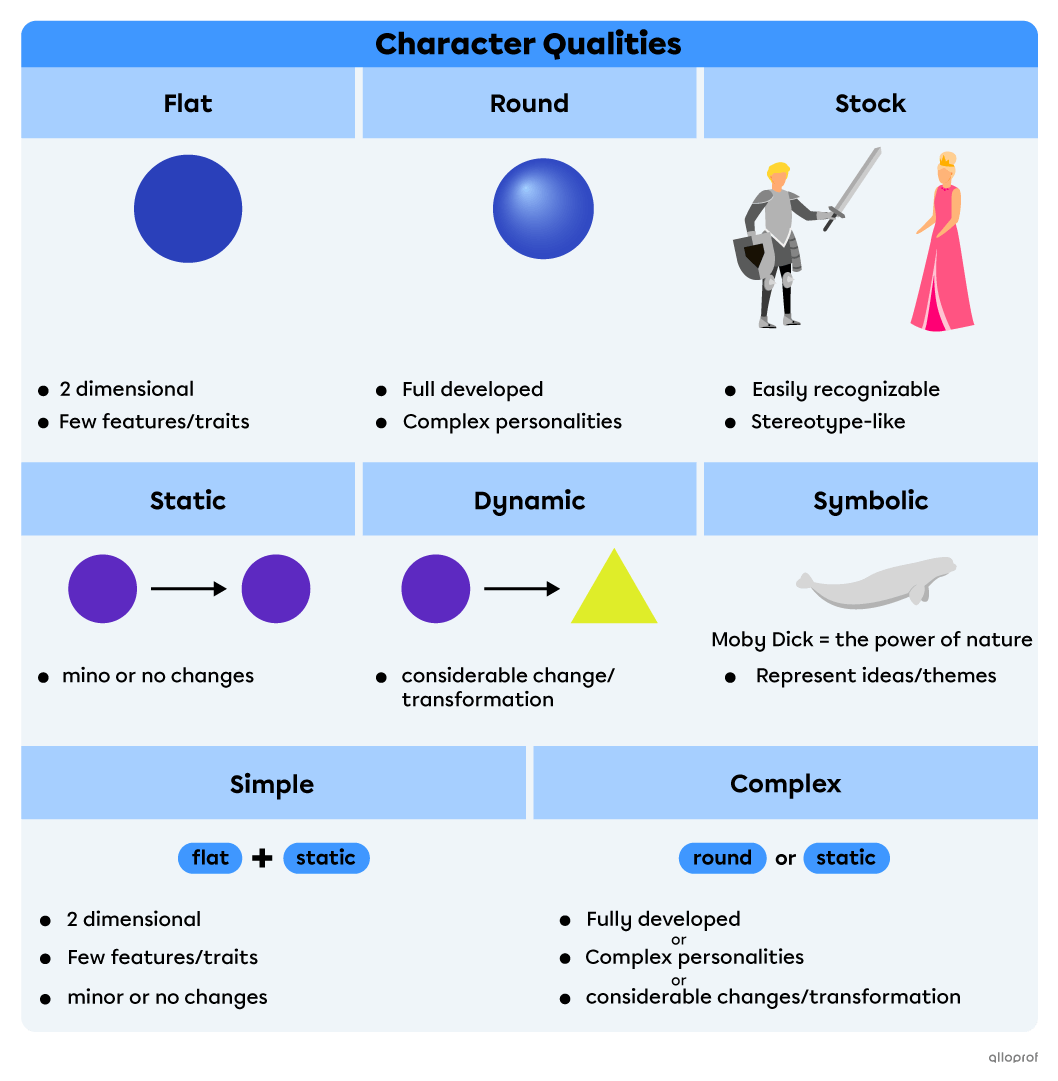In literature, characters are the representation of the people that inhabit a story.
No matter how many characters a story may hold, they do not all have the same weight. Some are more important and some may only show up once.
Here’s a brief overview of three categories they generally fit in.
| Main characters | Major characters |
| Impact on the plot/other characters | |
| Heart of the plot | |
| Audience surrogate; connect the audience and the story. | |
| Secondary characters | Somewhat important characters |
| Influence the plot/other characters in some ways | |
| Recurring characters | |
| Supporting characters | Minor characters |
| May impact the plot and other characters | |
| Also sometimes referred to as tertiary characters. |
A character’s role is the part it plays in a story. Each character has a different purpose, function and impact on the storytelling. Character roles are not absolute rules, they are general categories with some grey areas. The role a character is given is in service of the storytelling.
Here are some of the common character roles used in storytelling.
The protagonist is the character driving the plot. Whatever happens in a story impacts the protagonist, just as whatever a protagonist does impacts the story told.
Generally speaking, the protagonist is the main character of a story (But not always—see below for more on the topic).
Here are some the protagonist’s main features:
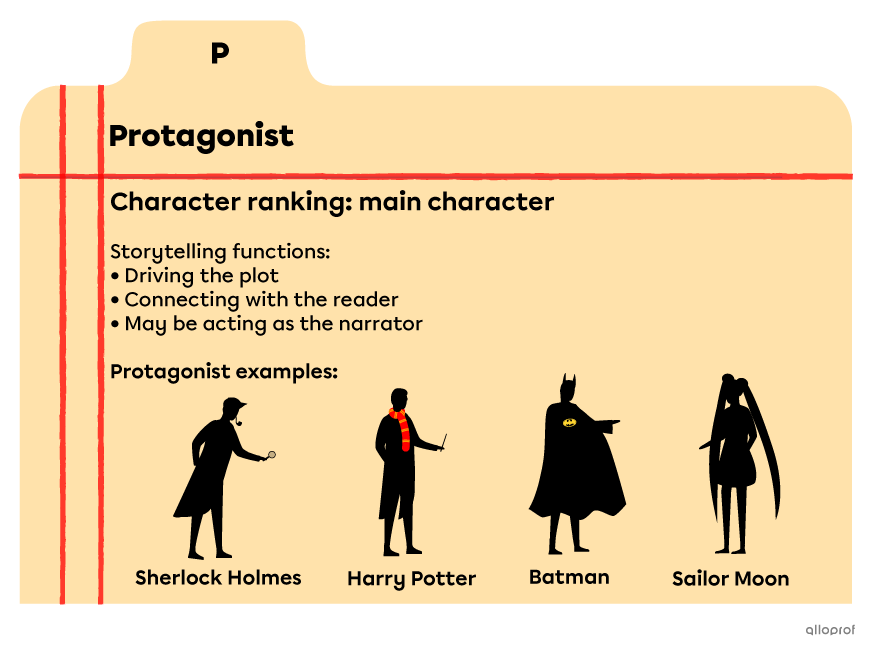
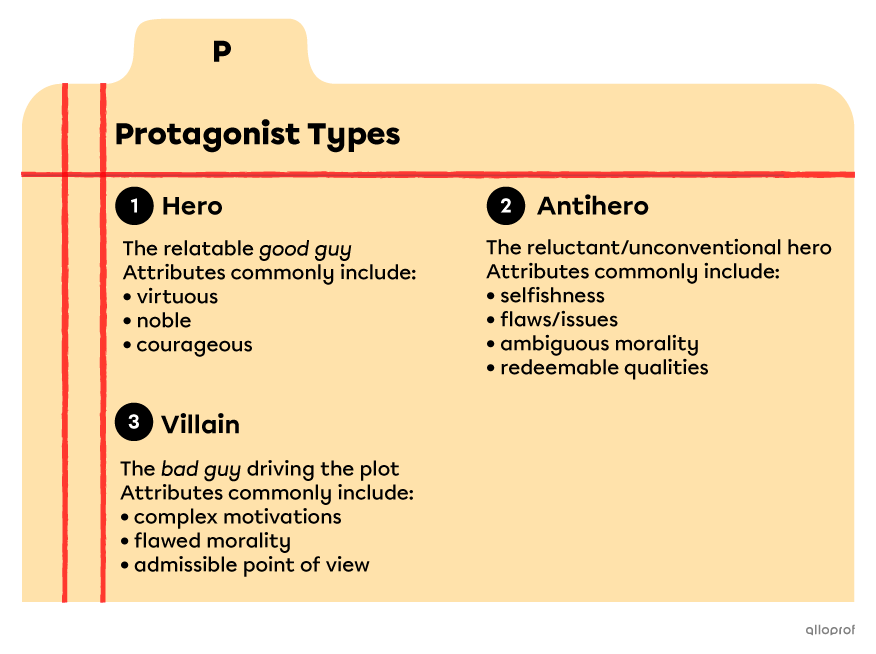
In most stories, the main character and the protagonist are one and the same. However, in some cases, the main character and the protagonist are two distinct characters.
It is the case when the main character isn’t driving the plot. Like when the main character is the narrator, telling a story he or she witnessed. The story is about a protagonist and is being told by a main character.
For example:
| The Great Gatsby (Fitzgerald, 1925). | |
| Main character (audience surrogate) | Nick Carraway: He is the narrator of the story, he is telling us what happened to The Great Gatsby. |
| Protagonist (drives the plot) | Jay Gatsby: The story is about him, they relate his actions. |
| Moby Dick (Melville, 1851) | |
| Main character (audience surrogate) | Ishmael: He is the narrator telling us about the hunt for the white whale. |
| Protagonist (drives the plot) | Captain Ahab: The story is about the captain’s actions and obsession. |
The antagonist is a character, or a force, whose main role is to oppose the protagonist. The antagonist creates conflict that challenges the protagonist, generates tension and forces the protagonist to act, all in service of making the story compelling for the audience. Antagonists can be main characters or secondary characters, depending on what the story calls for.
Here are some of its features:

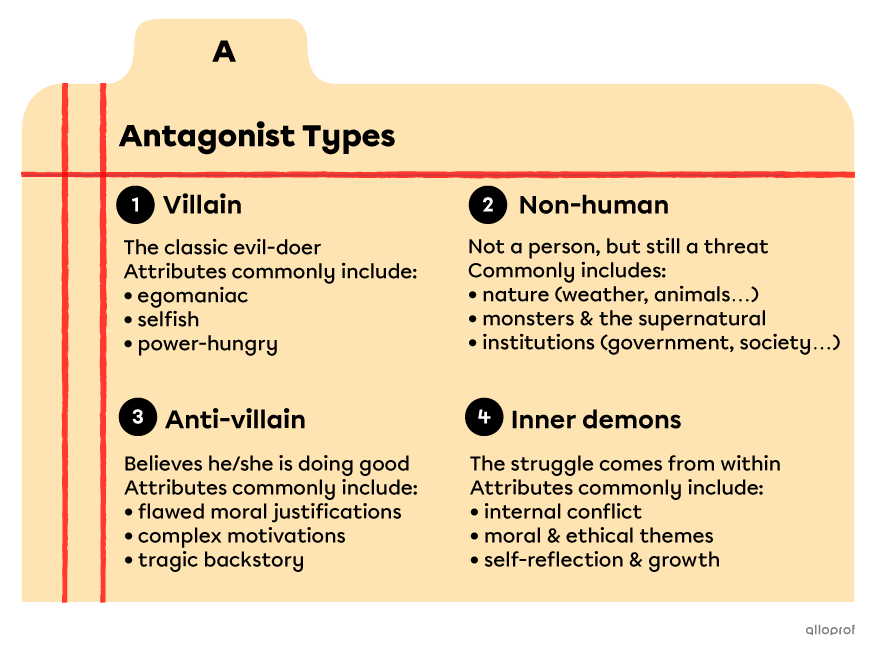
The deuteragonist is a literary term for a character almost as important as the protagonist. It serves the function of a secondary protagonist, the story is almost as much about them.
For example:
-
Dr. John Watson to the protagonist Sherlock Holmes in the Sherlock Holmes novels and short stories (Doyle, 1887-1927)
-
Ellis Redding (Red) to the protagonist Andy Dufresne in Rita Hayworth and Shawshank Redemption (King, 1982)
-
Samwise Gamgee to the protagonist Frodo in The Lord of The Rings series (Tolkien, 1945-1955)
The confidant character is very close to the protagonist. The confidant’s purpose is to provide support and/or guidance to the protagonist. This character’s role can take many different aspects (best friend, mentor, sibling…) and can also play other roles (love interest, foil, sidekick…). For the purpose of a story, the confidant can be a main character, a secondary character or a supporting character.
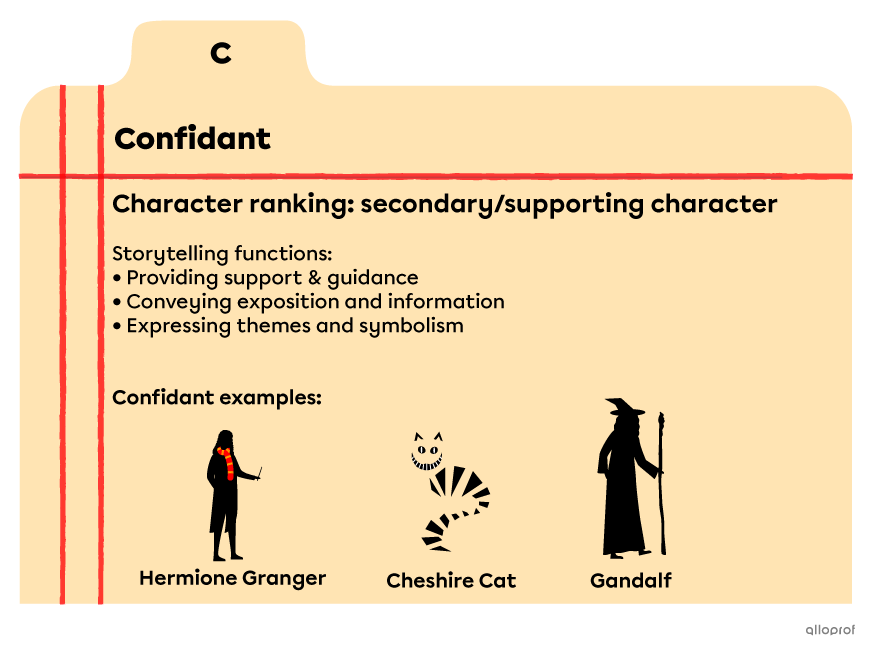
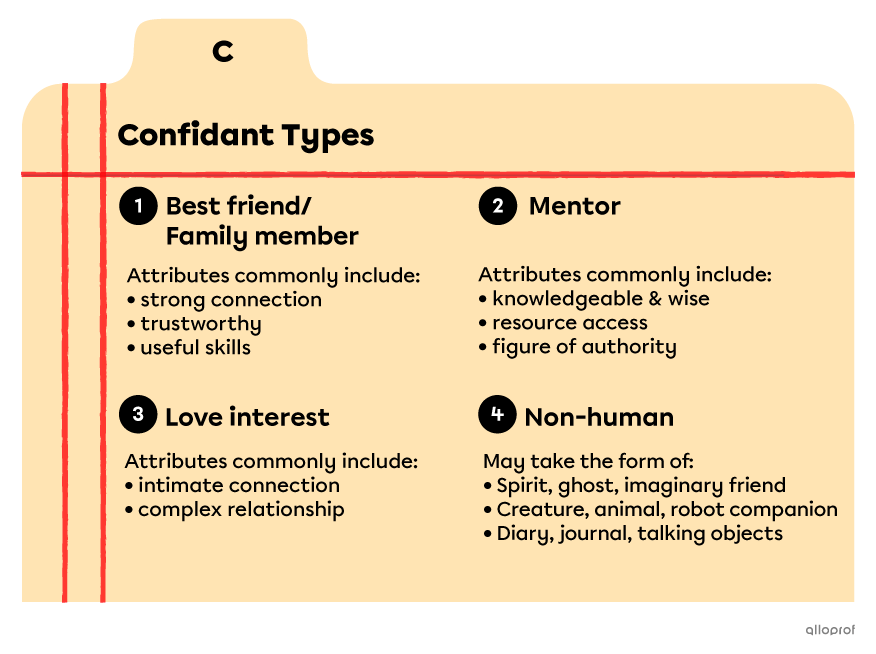
The foil character is used as a literary device in contrast to another character, usually the protagonist. The foil has contrasting personalities, abilities, traits, qualities and motivations to the protagonist. These contrasts highlight the protagonist’s own characteristics, making their strengths and weaknesses come out. For story purposes, the foil can be a secondary character or a supporting character.
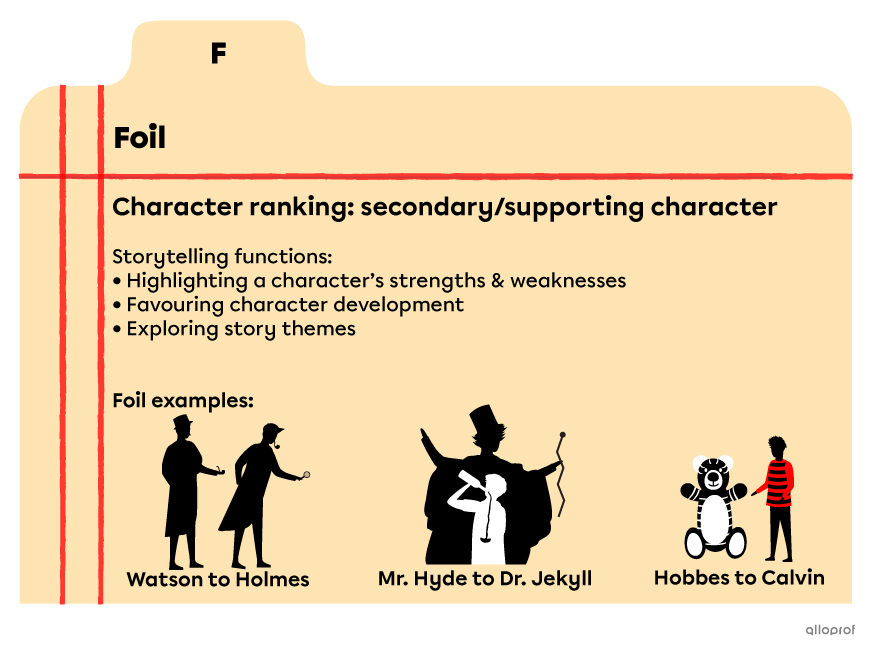
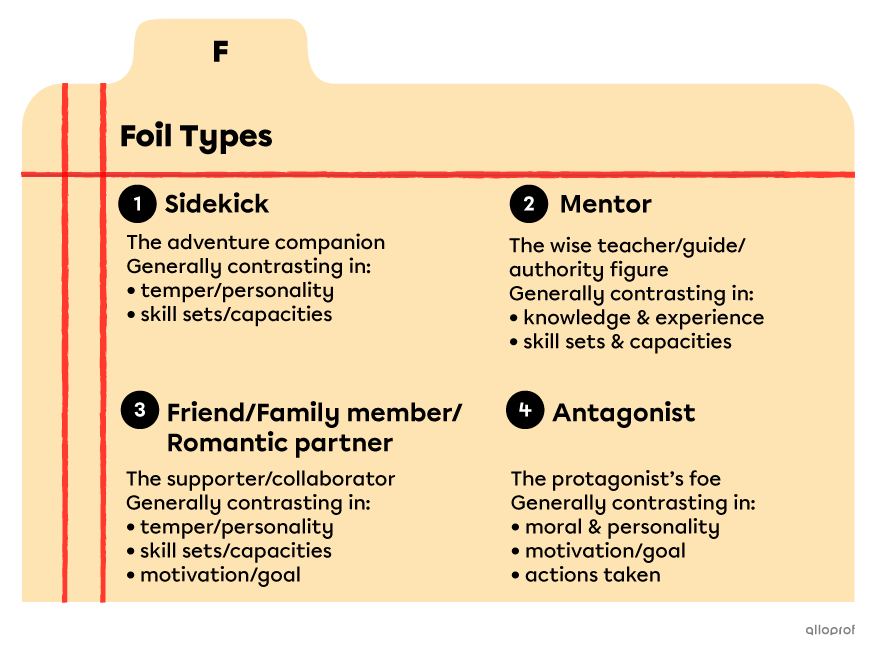
The love interest is a romantic interest or an object of desire for a character, generally the protagonist. This character influences the protagonist’s actions and may be the center of his/her own subplot. As a literary device, the love interest’s emotional connection with the protagonist (or other character) produces change and character development.
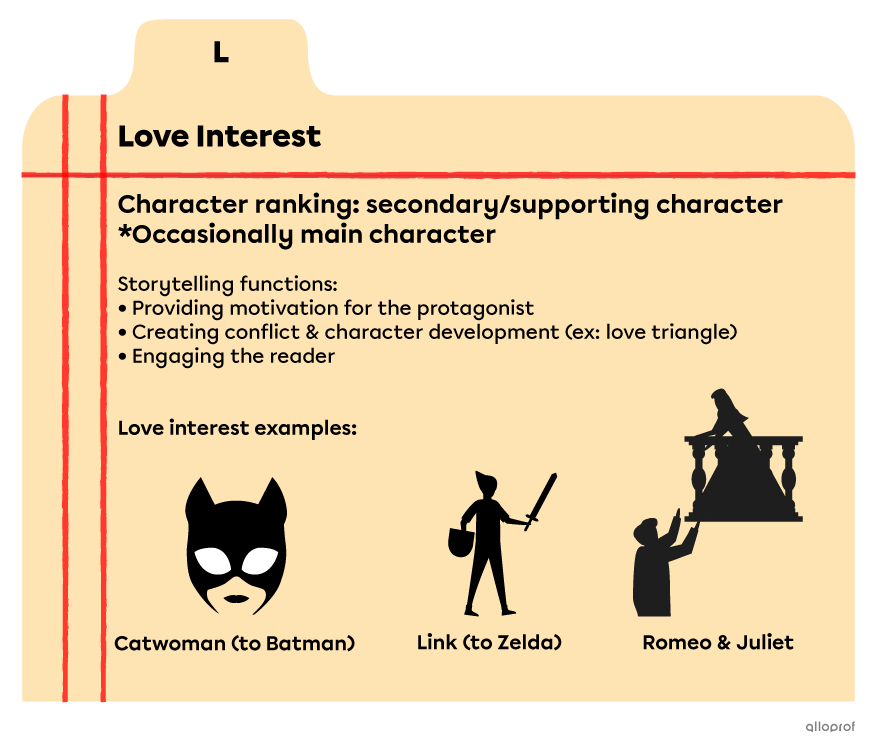
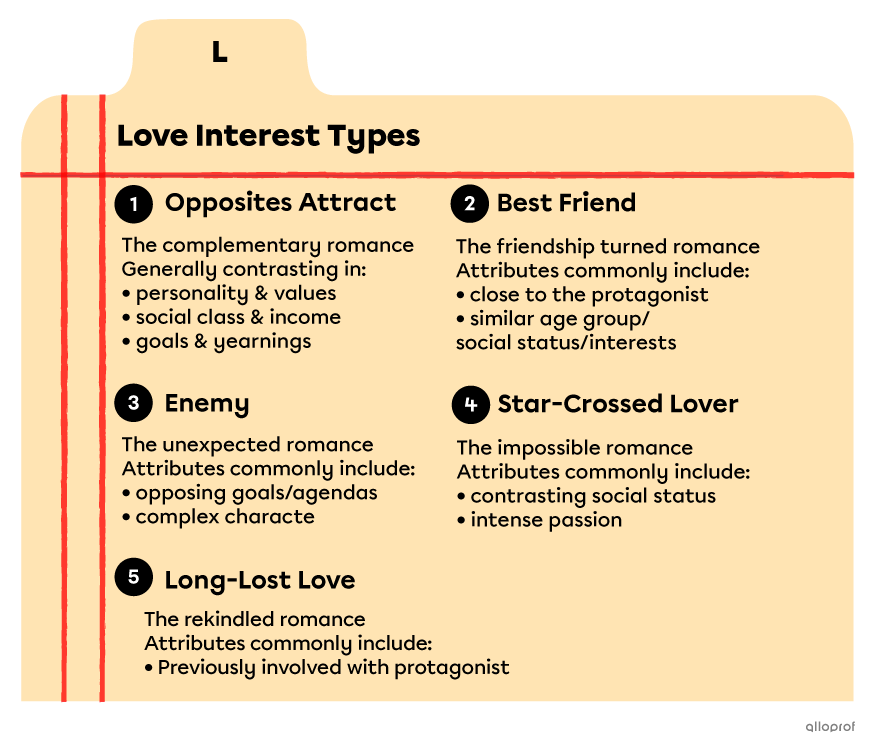
Supporting characters play any number of roles in a story. Their purpose is to help the story move along, with the role they play varying in importance, in frequency and in impact on the storyline itself. They are somewhat defined characters, often playing archetypes, usually with a specific role function allowing the plot to unfold.

For the types of supporting characters see the stock character section.
Characters can also be defined by a set of storytelling qualities. These qualities generally reflect the characters’ prominence and role played in a story.
| Flat Characters | Flat characters are somewhat defined, with only a few features or traits. They are commonly described as two dimensional. Flat characters have no complex personalities, emotions or motivations, and can generally be easily defined with a few words or a short sentence. |
| Round Characters | Round characters are well defined. They have fully developed personalities, a range of complex emotions and character defining motivations. They feel like real people more than story characters. They aren’t easily defined, they must be explained with a sentence or two. |
| Flat character examples | |
| Mad Hatter Alice’s Adventure in Wonderland (Lewis, 1865) | A looney hat maker living at a constant tea time. |
| Cruella de Vil The Hundred and One Dalmatians (Smith, 1956) | A cruel and wicked woman who wants puppies for their fur. |
| Veruca Salt Charlie and the Chocolate Factory (Dahl, 1964) | A spoiled, entitled little girl. |
| Round character examples | |
| Frodo Baggins The Fellowship of the Ring (Tolkien, 1954) | Despite his diminutive size and Hobbit disposition, Frodo proves to be quite the hero by showing bravery and selflessness. He is faced with inner turmoil, doubt and temptation throughout the dangerous quest thrust upon him. |
| Jay Gatsby The Great Gatsby (Fitzgerald, 1925) | An enigmatic and charismatic man with considerable wealth gained in questionable activities. He displays this wealth and his new found status in lavish parties to win back his lost love. |
| Ponyboy Curtis The Outsiders (Hinton, 1967) | An orphaned 14-year old boy living with his older Greaser brothers. He shows sensitivity, he does well in school and he is a dreamer. |
| Static Characters | Static characters are characters who more or less stay the same through a story. The minor changes they may undergo do not transform the characters: they are the same person at the beginning and at the end of a story. Static characters are commonly secondary characters and sometimes antagonists |
| Dynamic Characters | Dynamic characters are characters who undergo considerable change through a story. The changes are part of the storyline and explore themes as the character is developed. Generally speaking, most main characters are dynamic |
| Static character examples | |
| Atticus Finch To Kill a Mockingbird (Lee, 1960) | The character represents the blind justice that should only be affected by the law itself |
| Sherlock Holmes A Study in Scarlet (Doyle, 1887) | His personality and character are the same throughout his adventures. The character and the story both focus on solving and investigating crimes. |
| Captain Hook Peter Pan (Barrie, 1904) | The character’s obsession with revenge is his main unwavering feature. He is the classic villain. |
| Dynamic character examples | |
| Ebenezer Scrooge A Christmas Carol (Dickens, 1843) | A grumpy selfish old man becomes a compassionate and giving person. |
| Jim Hawkins Treasure Island (Stevenson, 1883) | Thrust into the world of piracy, Jim quickly learns about morality, danger, loyalty and ambiguity, discovering his abilities in leadership, self-reliance and undeniable courage. |
| Brian Robeson Hatchet (Paulsen, 1986) | A city boy from New York City becomes a self-sufficient survivor in the forest wilderness. |
| Simple Characters | Simple characters are both flat and static. They are minor one-note characters that do not change during the story. Simple characters generally have a very specific function in the storytelling. |
| Complex Characters | Complex characters are round and/or dynamic. They usually have a much bigger role than simple characters in a story. Readers have a better idea of who they are and how they act. |
| Simple character examples | |
| Cinderella’s step-sisters Cinderella (Perreault, 1697) | Two barely-described characters who are evil and do not evolve at all during the whole story. |
| Paddington Bear A Bear Called Paddington (Bond, 1958) | Character with a straightforward and innocent nature. Although he may not have intricate layers or complexities, his simplicity is a key aspect of his enduring appeal. |
| Mr. Jones Animal Farm (Orwell, 1945) | An abusive and alcoholic farm owner who remains as such during the whole story |
| Complex character examples | |
| George Milton Of Mice and Men (Steinbeck, 1937) | Having the task of taking care of his mentally challenged friend, this character faces many internal conflicts. George’s dreams and frustrations add to his complexity, displaying a strong, yet vulnerable man during the challenging Great Depression. |
| Celie The Color Purple (Walker, 1982) | In a segregated Georgia, in the early 1900s, this young African-American girl overcomes oppression and abuse to find fulfillment and independence. |
| Patrick Bateman American Psycho (Ellis, 1991) | Meticulously crafted character who offers a glimpse into the complexities of human nature and the challenges faced in the modern world |
Stock characters are easily recognizable types of characters, falling into somewhat generic personalities. They use stereotypes, the familiar and the predictable to be quickly and clearly understood by the audience. They can generally be defined with two to three words.
The following examples cover some common stock character types. Keep in mind that stock characters may be fleshed out and developed as a story unfolds.
| Examples of stock characters according to their occupation | |
| The absent-minded professor | |
| A brilliant character in a specific field, but forgetful and mostly inadequate in other aspects. | Albus Dumbledore in the Harry Potter series (Rowling, 1997-2007) |
| Professor Calculus in The Adventures of Tintin series (Hergé, 1929-1976) | |
| The hardboiled detective | |
| Rule-bending, and sometimes rule-breaking, investigators, presented as tough and cynical. | Philip Marlowe in The Big Sleep (Chandler, 1939) |
| Jessica Jones in the Alias series (Bendis, 2001-2004) | |
| The mad scientist | |
| Brilliant and usually eccentric scientists working on science advancement without necessarily worrying about morals and ethics. | Dr. Griffin in The Invisible Man (Wells, 1897) |
| Victor Frankenstein in Frankenstein (Shelley, 1818) | |
| The sleazy lawyer/politician/executive | |
| The corrupt character using the system to his/her advantages with no regards to the consequences around them. | Littlefinger (Petyr Baelish) in Game of Thrones (Martin, 1996) |
| Dr. Gonzo in Fear and Loathing in Las Vegas (Thompson, 1971) | |
| The thugs/henchmen/goons/minions | |
| Brutes working for a crime boss or an organization doing the dirty work. | The orcs in The Lord of the Rings series (Tolkien, 1954-1955) |
| The stormtroopers in the Star Wars movies (Lucas, 1977) | |
| Examples of stock characters according to their conduct/behaviour | |
| The action hero | |
| The resourceful hero showing courage and determination. | Jason Bourne in The Bourne Identity (Ludlum, 1980) |
| Katniss Everdeen in The Hunger Games (Collins, 2008) | |
| The bully | |
| A tormentor using intimidation tactics. | Miss Trunchbull in Matilda (Dahl, 1988) |
| Moe in Calvin and Hobbes (Waterson, 1985-1995) | |
| The comic relief | |
| The funny character, there to break the tension. | Fred and George Weasley in the Harry Potter series (Rowling, 1997-2007) |
| Manny in the Diary of a Wimpy Kid (Kinney, 2007) | |
| The everyman | |
| An ordinary, everyday person, with no heroic characteristics. | Winston Smith in 1984 (Orwell, 1949) |
| Arthur Dent in the Hitchhiker’s Guide to the Galaxy (Douglas, 1979) | |
| The evil twin | |
| An evil character reflecting, or related to, a hero character. | Mr. Hyde in Dr. Jekyll and Mr. Hyde (Stevenson, 1886) |
| King Louis XIV in The Man in the Iron Mask (Dumas, 1850) | |
| The lovable loser | |
| A likable character who suffers from bad luck or misadventures. | Charlie Brown in Peanuts (Schultz, 1950-2000) |
| Stanley Yelnats in Holes (Sachar, 1998) | |
| The lovable rogue | |
| The charming law breaker. | Robin Hood (legend, 13th century) |
| Mr. Fox in The Fantastic Mr. Fox (Dahl, 1970) | |
| The rebel | |
| The character who refuses to follow the system. | Jo March in Little Women (Alcott, 1868) |
| Guy Montag in Fahrenheit 451 (Bradbury, 1953) | |
| The swashbuckler | |
| The daring and witty adventurer. | Inigo Montoya in The Princess Bride (Goldman, 1973) |
| D’Artagnan in The Three Musketeers (Dumas, 1844) | |
| Examples of stock characters according to their interests | |
| The geek* | |
| Characters with particular interests or hobbies, often portrayed as eccentric or quirky. | Wade Watts in Ready Player One (Cline, 2011) |
| Violet Baudelaire in the Series of Unfortunate Events series (Snicket, 1999-2006) | |
| The jock | |
| A popular and athletic character. | Hermes in The Lightning Thief (Riordan, 2005) |
| Dean Moriarty in On the Road (Kerouac, 1957) | |
| The nerd* | |
| Intellectual characters pursuing knowledge and academic expertise. Generally portrayed as socially awkward. | Hermione Granger in the Harry Potter series (Rowling, 1997-2007) |
| Ender Wiggin in Ender’s Game (Card, 1985) | |
| The recluse | |
| The hermit character living in isolation. | Boo Radley in To Kill a Mockingbird (Lee, 1960) |
| Willy Wonka at the beginning of Charlie and the Chocolate Factory (Dahl, 1964) | |
| The slacker | |
| The underachiever character. | Scott Pilgrim in Scott Pilgrim’s Precious Little Life (O’Malley, 2004) |
| Holden Caulfield in The Catcher in the Rye (Salinger, 1951) | |
*The geek and nerd character types are often mixed to form one character. The expressions are regularly used interchangeably.
| Examples of stock characters according to their skills/knowledge | |
| The ace | |
| Ridiculously good at what they do. | Jack Reacher in the Killing Floor (Child, 1997) |
| Westley in The Princess Bride (Goldman, 1973) | |
| The dumb beauty | |
| Beautiful with little common sense. | Rosemary Barton in Sparkling Cyanide (Christie, 1944) |
| Isabel Archer in The Portrait of Lady (James. 1881) | |
| The grizzled warrior/old soldier | |
| The experienced, battle-hardened character who has seen it all. | Gimli in the Lord of the Rings series (Tolkien, 1954-955) |
| John Rambo in First Blood (Morrell, 1972) | |
| The mystic | |
| The character with out of this world powers or abilities. | The Cheshire Cat in Alice’s Adventure in Wonderland (Carroll, 1865) |
| John Coffey in The Green Mile (king, 1996) | |
| The old master/wise old man | |
| The experienced mentor and/or counselor. | The Giver character in The Giver (Lowry, 1993) |
| Aslan in The Lion, the Witch and the Wardrobe (Lewis, 1950) | |
| The wise fool | |
Simple minded at first glance, but there is more than meets the eyes. | Puck in A Midsummer Night’s Dream (Shakespeare, 1595) |
| Forrest Gump, the titular character, in Forrest Gump (Groom, 1986) | |
Symbolic characters are characters who represent ideas, concepts or themes. This symbol personification allows authors to explore deeper ideas, larger concepts and more complex themes.
Character | Symbol represented |
| Captain Ahab Moby-Dick (Melville, 1851) | Captain Ahab represents obsession and the destructive nature of humans. His quest for vengeance is consuming his entire life and ultimately leads to his demise. |
| Gollum The Hobbit (Tolkien, 1937) | Gollum represents the seductive and destructive nature of power. The One Ring corrupted him and turned him into the creature he now is. |
| Victor Frankenstein Frankenstein (Shelley, 1818) | Victor Frankenstein represents a cautionary tale in the consequences of blind ambition. He must face the responsibility, the implications and the morality of his actions. |
